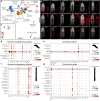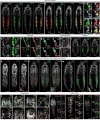This is a preprint.
Regeneration in the absence of canonical neoblasts in an early branching flatworm
- PMID: 38853907
- PMCID: PMC11160568
- DOI: 10.1101/2024.05.24.595708
Regeneration in the absence of canonical neoblasts in an early branching flatworm
Update in
-
Regeneration in the absence of canonical neoblasts in an early branching flatworm.Nat Commun. 2025 Jan 31;16(1):1232. doi: 10.1038/s41467-024-54716-x. Nat Commun. 2025. PMID: 39890822 Free PMC article.
Abstract
The remarkable regenerative abilities of flatworms are closely linked to neoblasts - adult pluripotent stem cells that are the only division-competent cell type outside of the reproductive system. Although the presence of neoblast-like cells and whole-body regeneration in other animals has led to the idea that these features may represent the ancestral metazoan state, the evolutionary origin of both remains unclear. Here we show that the catenulid Stenostomum brevipharyngium, a member of the earliest-branching flatworm lineage, lacks conventional neoblasts despite being capable of whole-body regeneration and asexual reproduction. Using a combination of single-nuclei transcriptomics, in situ gene expression analysis, and functional experiments, we find that cell divisions are not restricted to a single cell type and are associated with multiple fully differentiated somatic tissues. Furthermore, the cohort of germline multipotency genes, which are considered canonical neoblast markers, are not expressed in dividing cells, but in the germline instead, and we experimentally show that they are neither necessary for proliferation nor regeneration. Overall, our results challenge the notion that canonical neoblasts are necessary for flatworm regeneration and open up the possibility that neoblast-like cells may have evolved convergently in different animals, independent of their regenerative capacity.
Figures






Similar articles
-
Regeneration in the absence of canonical neoblasts in an early branching flatworm.Nat Commun. 2025 Jan 31;16(1):1232. doi: 10.1038/s41467-024-54716-x. Nat Commun. 2025. PMID: 39890822 Free PMC article.
-
What role do annelid neoblasts play? A comparison of the regeneration patterns in a neoblast-bearing and a neoblast-lacking enchytraeid oligochaete.PLoS One. 2012;7(5):e37319. doi: 10.1371/journal.pone.0037319. Epub 2012 May 16. PLoS One. 2012. PMID: 22615975 Free PMC article.
-
Stem cells in asexual reproduction of Enchytraeus japonensis (Oligochaeta, Annelid): proliferation and migration of neoblasts.Dev Growth Differ. 2012 May;54(4):439-50. doi: 10.1111/j.1440-169X.2012.01328.x. Epub 2012 Mar 15. Dev Growth Differ. 2012. PMID: 22417296
-
Cellular and molecular dissection of pluripotent adult somatic stem cells in planarians.Dev Growth Differ. 2010 Jan;52(1):27-41. doi: 10.1111/j.1440-169X.2009.01155.x. Dev Growth Differ. 2010. PMID: 20078652 Review.
-
Neoblasts and the evolution of whole-body regeneration.Curr Opin Genet Dev. 2016 Oct;40:131-137. doi: 10.1016/j.gde.2016.07.009. Epub 2016 Aug 4. Curr Opin Genet Dev. 2016. PMID: 27498025 Review.
References
-
- Baguñà J: The planarian neoblast: the rambling history of its origin and some current black boxes. International Journal of Developmental Biology 2012, 56(1–2-3):19–37. - PubMed
-
- Peter R, Gschwentner R, Schürmann W, Rieger RM, Ladurner P: The significance of stem cells in free-living flatworms: one common source for all cells in the adult. Journal of Applied Biomedicine 2004, 2(1):21–35.
-
- Reddien PW, Alvarado AS: Fundamentals of planarian regeneration. Annu Rev Cell Dev Biol 2004, 20:725–757. - PubMed
Publication types
Grants and funding
LinkOut - more resources
Full Text Sources
